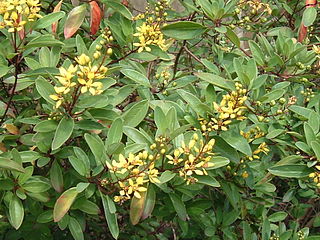Carolus is a genus in the Malpighiaceae, a family of about 75 genera of flowering plants in the order Malpighiales. Carolus comprises six species of woody vines native to Mexico, Central America, the Lesser Antilles, and South America.
Adelphia is a genus in the Malpighiaceae, a family of about 75 genera of flowering plants in the order Malpighiales. Adelphia comprises four species of woody vines native to the West Indies, Mesoamerica, and western South America.
Alicia is a genus in the Malpighiaceae, a family of about 75 genera of flowering plants in the order Malpighiales. Alicia comprises 2 species of woody vines widespread in South America.

Hiptage is a genus in the Malpighiaceae, a family of about 75 genera of flowering plants in the order Malpighiales. Hiptage comprises 30 species of vines and woody shrubs growing in forests of tropical southeastern Asia from Pakistan and India to Taiwan, the Philippines, and Indonesia. The genus is distinctive in its three-winged samaras; most species bear an elongated commissural gland on the calyx.
Barnebya is a genus in the Malpighiaceae, a family of about 75 genera of flowering plants in the order Malpighiales. Barnebya comprises 2 species of trees and woody vines native to eastern Brazil. The genus is named in honor of the American botanist Rupert Charles Barneby (1911–2006).
Thryallis is a genus in the family Malpighiaceae, of scandent shrubs and woody vines native to Brazil and adjacent Paraguay and Bolivia.

Galphimia is a genus in the Malpighiaceae, a family of about 75 genera of flowering plants in the order Malpighiales; the name is an anagram of Malpighia.Galphimia comprises 26 species of large herbs, shrubs, and treelets. Twenty-two species occur in Mexico, one extending into Texas and one ranging to Nicaragua; four species occur in South America, south of the Amazon Basin. Galphimia gracilis is widely cultivated in warm regions throughout the world. Eight species are distinctive in that the petals become stiff and papery, and persist past the stage of fruit maturation.

Mascagnia is a genus in the Malpighiaceae, a family of about 75 genera of flowering plants in the order Malpighiales. The genus Mascagnia comprises about 45 species that occur in diverse habitats from northern Mexico and the Caribbean to northern Argentina and south-eastern Brazil.

Stigmaphyllon is a genus in the Malpighiaceae, a family of about 75 genera of flowering plants in the order Malpighiales. Amazonvine is a common name for species in this genus.
Coleostachys is a genus in the Malpighiaceae, a family of about 75 genera of flowering plants in the order Malpighiales. Coleostachys contains only one species of shrubs or treelets found in wet forests of the Amazonian lowlands of French Guiana and adjacent Brazil.
Ectopopterys is a genus in the Malpighiaceae, a family of about 75 genera of flowering plants in the order Malpighiales. Ectopopterys contains only one species of woody vines native to lowland wet forests of Colombia, Ecuador, and Peru.
Mcvaughia is a genus in the Malpighiaceae, a family of about 75 genera of flowering plants in the order Malpighiales. Mcvaughia contains only one species, Mcvaughia bahiana, a shrub occurring in open shrubby vegetation (caatinga) on sandy soils of lowland Bahia, Brazil. It is related to Burdachia and Glandonia.
Blepharandra is a genus in the Malpighiaceae, a family of about 75 genera of flowering plants in the order Malpighiales. Blepharandra comprises 6 species of trees and shrubs native to sandy savannas and scrub forests of Guyana, southern Venezuela, and Amazonian Brazil.
Excentradenia is a genus of plants in the family Malpighiaceae. Excentradenia comprises four species of woody vines native to the forests of northern South America.
Psychopterys is a genus in the Malpighiaceae, a family of about 75 genera of flowering plants in the order Malpighiales. Psychopterys comprises 8 species of woody vines, occasionally described as shrubs or small trees, which occur in matorral, tropical deciduous forest, and wet forest in southern Mexico, Guatemala, and Belize. This genus is very distinctive because of its nearly radial white corollas and eglandular sepals, which are highly unusual characteristics in the Malpighiaceae of the New World.

Callaeum is a genus in the Malpighiaceae, a family of about 75 genera of flowering plants in the order Malpighiales. Callaeum comprises 11 species of woody vines and shrubs occurring from western Texas to Mexico, Central America, and South America. Two species, C. macropterum and C. septentrionale are cultivated as ornamentals in Arizona and California.
Christianella is a genus in the Malpighiaceae, a family of about 75 genera of flowering plants in the order Malpighiales. Christianella comprises 5 species of woody vines and shrubby habit occurring in forests, roadside thickets, and shrubby savannas in southeastern Mexico, Central America, and South America.

Aspidopterys is a genus of Malpighiaceae, a family of about 75 genera of flowering plants in the order Malpighiales. Aspidopterys comprises approximately 15 species of vine native to Asia.
Callaeum antifebrile is a South American jungle vine of the family Malpighiaceae which occurs predominantly throughout the Upper Amazon basin, and less frequently along the Lower Amazon. Occasionally a component in ayahuasca decoctions, it is used as a folk medicine in some parts of Brazil, often as an antifebrile (anti-fever) remedy.
Madagasikaria is a genus in the Malpighiaceae, a family of about 75 genera of flowering plants in the order Malpighiales. Madagasikaria contains only one species of woody vines native to deciduous seasonally dry forest of Madagascar.





